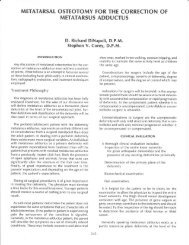CHAPTER 11 59threaded, whereas the SR-PLLA screw is availablefully- or partially-threaded. Current criteria for theuse of BIOFIX screws include humeral head fractures,olecranon fractures, condylar fractures of thehumerus, condylar fractures of the distal femur orproximal tibia, displaced ankle fractures, and anklearthrodesis.5 <strong>The</strong>y have also been used successfullyin subtalar afihrodesis.<strong>The</strong> most significant difference between theSR-PGA and SR-PLLA screws is strength retention.<strong>The</strong> SR-PGA screw is stronger, but the SR-PLLAscrew persists longer.' <strong>The</strong> SR-PGA screw loses itsmechanical resistance in vivo between 30-60 days,and the SR-PLLA screw between 3-72 months.Biodegradation time, or time to complete absorption,is 5-10 months for the SR-PGA material, and variesfrom 15 to 60 months for SR-PLLA materiai. <strong>The</strong> actualtime depends on shape, size, molecular weight, andvariable tissue environments of implantation.<strong>The</strong> initial resistance to shear and flexion forcesof the screws is 20-30 times that of cancellousbone. <strong>The</strong>ir modulus of elasticity is comparableto cortical bone, and roughly 2-3 times that ofcancellous bone. By comparison, the modulus ofelasticity of stainless steel is rnore than 20 times thatof cancellous bone. Clinically, the decrease inbending strength is more rapid than that of shearstrength.3'5 <strong>The</strong> screws require a dedicated screwdriver, tap, and countersink. A11 instrumentationpieces are compatible with the standard AO/ASIFquick release handles (Fig. 1).<strong>Screw</strong> InsertionInsertion of the screws requires attention to technique,and the following specifics are recommended by themanufacturers. Reduction of the osseous componentsis achieved and stabilized with clamps.Specific to ankle fracture repair, the screw is inserled75-85 degrees to the fracture line, as opposed to 90degrees. If the reduction is exact, the direction offixation is not the same as the rotational axis of thefragment, since rotation is not possible without anew fracture or failure of fixation.' <strong>The</strong> drill and/orover-drill hole is made with the corresponding sizedrills. Tapping is performed with care to ensurecrossing the entire length of the hole. <strong>The</strong> near cortexis then countersunk. <strong>The</strong> screw channel isflushed with saline and the screw insefied. <strong>The</strong> headof the screw is then cut so that only 1 mm remainsabove the cofiex.Since the torsional strength of the absorbablescrew is not as high as that of a metallic implant,care must be taken when inserting the screw. <strong>The</strong>screw must turn easily into the bone, otherwise itmay break. If a screw breaks, the exposed portionof screw is cut flush with the bone, rather thanattempting to remove it. A few reasons for screwbreakage are suggested by the Finnish surgeons:the drill hole may not be long enough; the tappingmay have been done improperly; or the drill holemay have been dry. Lastly, the longer the screw,the more chance for increasing the friction forceson the screw. <strong>The</strong>refore, extra care should be takenduring insertion.5Figure 1. <strong>The</strong> tips of the screw driver, countersink, and tap requiredfor the BIOFIX absorbable screws. Note the size of the countersinkcompared to a standard AO/ASIF countersink.AdvantagesIn direct comparison with metallic screws, severalfeatures of absorbable screws are highlighted bythe manufacturers. <strong>Absorbable</strong> implants essentiallyeliminate the financial burden of secondary proceduresto remor,e internal fkation. This is oftenregarded as a psychological benefit as well, pafiicularlyin children. Magnetic resonance and computedtomography imaging are also possible without thescattering caused by metallic devices. <strong>The</strong> absorbablematerial is considered tissue equivalent. <strong>Absorbable</strong>screws may also be left in sites of infection as theyare bacteriostatic. Growing bacteria do not affect theabsorption of the screws. <strong>The</strong> relationship betweenthese screws and the presence of stress protection orstress shielding has akeady been discussed.
60 CHAPTER 11PrecautionsBIOFX screws are not recommended in patients over70 years of age. Caution is also advised in any patientwith advanced osteoporosis or a coruninuted fracture.In those patients with rheumatoid disease, andin cases of ankle afihrodesis, only the SR-PLIAimplants are advised. Lastly, the SR-PGA screws arespecifically recommended for transyndesmoticflxation when necessary in standard ankle fracturemaflagement. Furlher contraindications for their useinclude alcoholism or psychiatric disorders which limitthe patient's ability to cooperate.<strong>The</strong> most significant precaution regarding thebioabsorbable screws is the periodic developmentof a local fluid accumulation. This has beenobserved at 8-72 weeks after surgery utilizing SR-PGA screws and tB-36 months involving theSR-PLLA screws. <strong>The</strong> most recent literature reportsa complication rate of 0-40/0,This appears to be a nonspecific, foreign bodyreaction that is noninfectious and unique toabsorbable fixation. <strong>The</strong>re are varying grades ofpresentation of this soft tissue response. If the reactionis clinically noticeable, but sma1l and painless,it may only be obserued. If it is red and inflamed,painful, and larger than 1.5 centimeters in diameteqit should be aspirated. On occasion, a sinus tract orfistula will form that should be incised and drained.<strong>The</strong> fluid is viscous, yellow to clear, and aseptic.<strong>The</strong> wound will completely resolve within 10weeks. This reaction has no effect on the final outcomeof the osseous surgery or functional recovery.are available. Howeveq the authors offer somegeneral obseruations regarding the feasible uses inpodiatric surgery.<strong>The</strong> currently avarlable screw sizes are applicableto selected forefoot, midfoot, rearfoot andankle surgical procedures. <strong>The</strong> thread geometry ofthe screws is unique. <strong>The</strong> profile most closelyresembles a 3.5-mm AO/ASIF cortical screw withthe pitch a 4.0-mm cancellous AOIASIF screw,however, they are not identical (Fig. 2). <strong>The</strong> screwhead is rectangular-shaped and slightly larger thanan AOIASIF screw of the same size (Figs. lA, 3B).<strong>The</strong> screw head does not contain a hexagonalFigure 2. <strong>The</strong> thread pitch of a BIOFIX screw is 1.75-mm, the same as a,1.0-mm cancellous AO/ASIF screw. <strong>The</strong> thread profile is shallower andcoarser in comparison to standard metallic screws. Left, AO/ASIF 4.0-mmcancellous, Center. SR-PLLA 3.5-mm, Right, AO,/ASIF 3.5-mm cortical.EARLY CLINICAL IMPRESSIONS ANID APODIAIRIC PERSPECTTVE<strong>The</strong> research and clinical experience regardingabsorbable materials such as rods, screws, membranes,and tacks, is vast. More than 15 doctoraltheses and over 600 scientific studies have beenpublished entailing animal studies and humantrials.6 However, clinical and scientific investigationin North American literature is in its infancy in respectto absorbable screws. Our clinical use of these screwsat this time is limited to first metatarsophalangealarthrodesis, hallux interphalangeal arthrodesis, andproximal first metatarsal osteotomies. Any impressionwith regard to long-term efficacy in these applicationsis premature. Since this is the first report of suchclinical use in the world literature, no comparisonsFigure JA. A comparison of screw head sizes and shapes. left, SR-PLLA 4.5-mm, Center, AO/ASIF 3.5-mm, Right, SR-PLLA 3.5-mm.

















